|
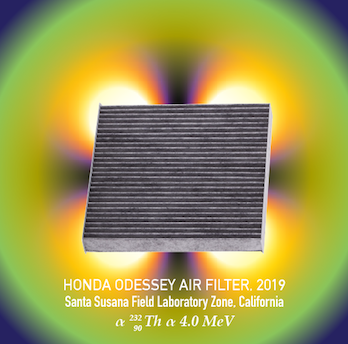 |
Honda Odessey vehicle air filterThis filter was used in and around the 2018 Woolsey fire; a fire that released radioactive microparticles into the air. These radioactive particles, diagnostic of the burned former (but still radiologically-contaminated) Santa Susana nuclear research center, were trapped onto and harvested from this air filter, see: Kaltofen, 2021.
|
|
Below: 360 air filter, soil, ash and dust samples were collected by citizen scientists, whose results were published in a peer-reviewed journal.
|
|

|
|
(Below) This headlamp was worn by an oil services worker. The lamp set is coated with grime from handling fracking wastes. The grime is high in radium-226, a naturally occurring radioactive material often associated with fracking and oil & gas production. At below right is a 10-day autoradiographic image of the lamp set. Star-shaped tracks from alpha and beta radiation is visible in the developed blue-sensitive X-ray film (Ilford development chems., 5 minute developer time at 70 deg. F.).

|
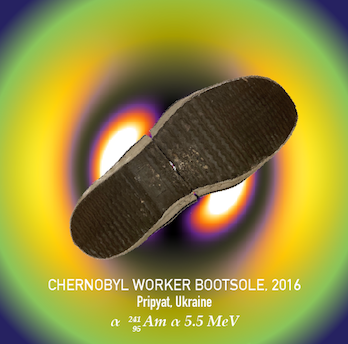 |
Sole of a Chernobyl worker's bootDespite the presence of boot cleaning stations like this one at the Chernobyl Nuclear Power Station in Ukraine, worker and visitor boots still carry radioactive materials back to workers' homes and families. Testing by Unfriending the atom found radioactive contamination from americium-241 and cesium-137 on this donated boot sole. In a detailed study by UTA's Dr. Kaltofen, transfer of radioactive dust from nuclear workers to their homes is detailed in: EES 2018. (Below: @CleanFutureFund photo).
|
|
(Below) Boot wiper at entrance to Chernobyl clean area. (Bottom) X-ray spectrum for a radioactive microparticle from the pictured boot sole showing thorium-monazite and traces of metals used in the core assembly including lead, copper and zinc; as well as strontium - a common light fission product. The boot sole was primarily contaminated with the heavy fission product Cs137 but no cesium was found in this particle.
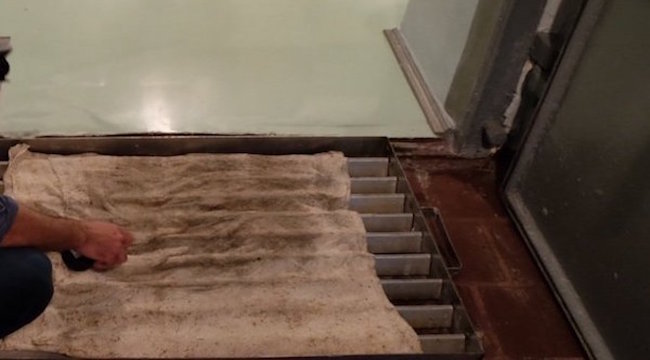

|
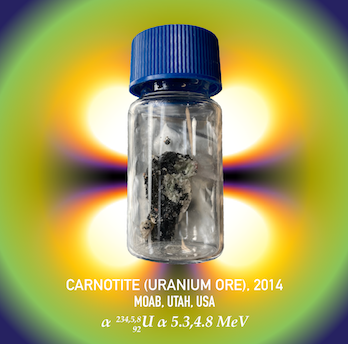 |
| Carnotite uranium ore from Moab, UtahThe American southwest, and First Nations lands in particular, host many of the sites from which uranium was mined and milled, leaving behind a landscape crowded with the detritus of radioactive resource extraction. As often happens, indigenous peoples bear a disproportionate burden of the militarization of atomic industries.
|
| Below: A 1979 AP file photo showing United Nuclear Corp. uranium tailings operations related to the catastrophic Church Rock, NM., mine tailings disaster on July 16. 1979; contaminating populated Navajo lands- the largest-ever USA radiation release accident.

|
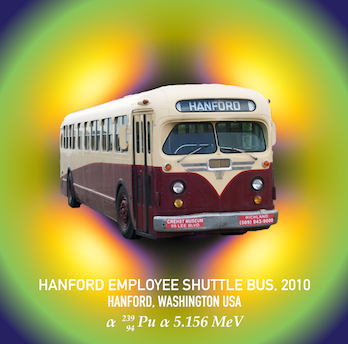 |
| Original war-time Hanford busDust from Hanford Nuclear Reservation 1940's employee shuttle bus, collected by the zoo keeper and analyzed for traces of radioactive contamination potentially spread from worker clothing and gear.
|
| Below, L to R: Sampling the bus engine air filters in the rehab shop, finished bus on display, Zoo keeper sampling dust wipes from the bus cab interior.

|
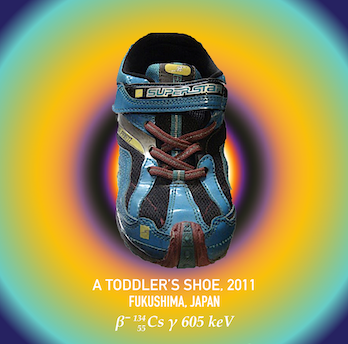 |
| Toddler's shoe donated by a mom from JapanThe 2011 Fukushima meltdowns released vast amounts of radioactive microparticles into the atmosphere. These radioactively-hot particles were readily found on the many shoes donated to assess personal nuclear contamination on childrens' personal items. In the image below, radiation trapped on car air filters exposed photographic film sheets, leaving a record of cesium-137 and Iodine-131 in the nuclear microparticles swirling in the air, just as they were trapped on shoe laces and shoes. For a detailed look at radioactive dust in Japan, see: Kaltofen, et al., 2017.
|
| From below left to below right, autoradiographs on X-ray film from three April 2011 car air filters, collected from Seattle, WA, USA; Tokyo, Japan; Fukushima City, Fukushima Prefecture, Japan. (Bottom) Prepping the shoe for radiographic analysis.


|
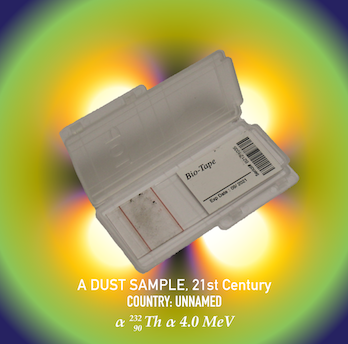 |
Recovered fragment from an unnamed 21st Century nuclear weapons facilityCase containing a microscopic fragment of material used for a nuclear device. For a detailed look at how nuclear workers carry radioactive fragments of their work back to their families, see: Kaltofen, 2018.
|
|
From below left to below right, X-ray spectra of uranium/thorium alloy collected from a known US nuclear weapons manufacturer (from a Hanford-area building air filter), and an almost identical nuclear alloy from a 21st Century nuclear weapons facility elsewhere.
|
|

|
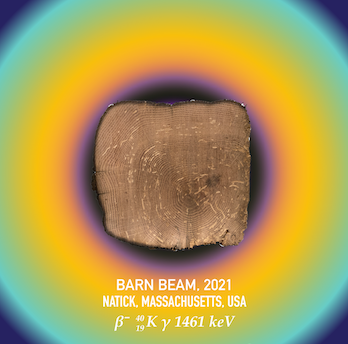 |
18th Century New England barn beamThis barn beam (cut in 1815) was completely free of radioactive fallout from atomic testing, and was hand delivered to the zoo keeper after a catastrophic barn fire in 2021, see: PSR, 2021
|
|
Below: The wood and ash from this sample were used to provide an uncontaminated baseline for a study of low-level radioactive contamination spread by the 2018 Woolsey Wildfire at the Santa Susana former nuclear reactor complex in the outskirts of Los Angeles, CA. The beam and fire debris were donated by the Natick Community Organic Farm in Natick, MA. (Photo credits, NCOF 2021)
|
|

|
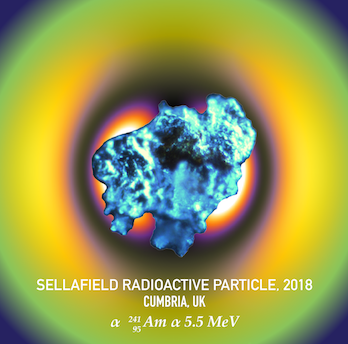 |
Radioactive microparticle containing americium-241. This particle (and others) were extracted from samples of beach sand and estuarine sediments. The samples contain Am-241 and Cs-137 from the Sellafield British Nuclear Fuels site in Cumbria in the UK.
|
|
Below: Complete list of Am-241 and Cs-137 activities found by WPI researchers for Sellafield-area public beach and related samples.
|
|
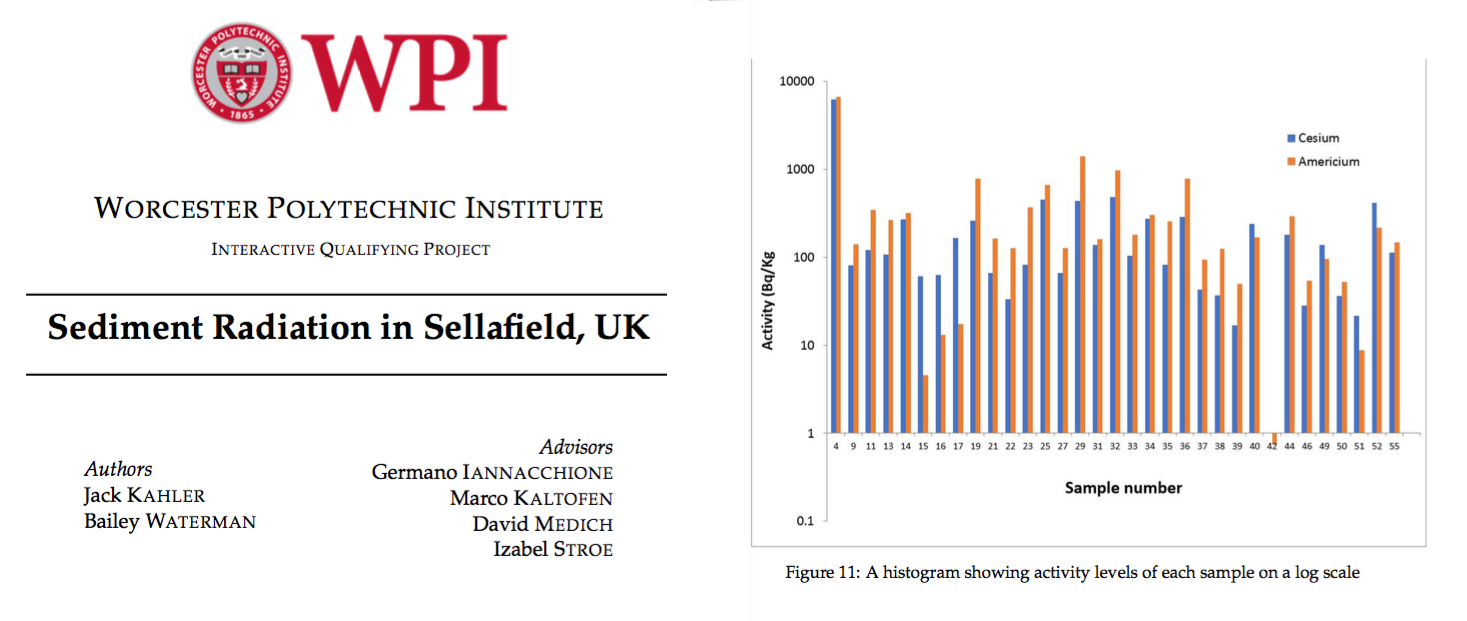
|
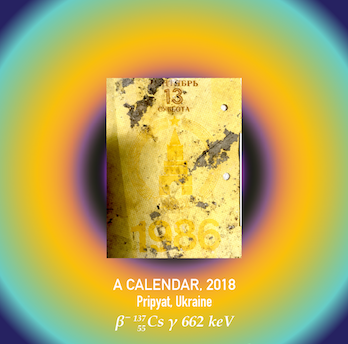 |
Abandoned desk calendar page - Pripyat Hospital #4A page from an abandoned desk calendar, showing the last date prior to evacuating from Pripyat, due to the Chernobyl disaster, the Soviet Union's worst nuclear accident. The page has a heavy load of cesium-137 still trapped in the paper. Donated to the zoo by @CleanFutureFund, an animal rescue charity in Ukraine. (below: IAEA photo of Chernobyl NPS) |

Harvard University Artist Dan Borelli @danborelli and Dr. Marco Kaltofen, @MKaltofen, a Registered Professional Engineer, are the keepers of a global radioactive zoo; collecting samples, objects, and stories from locally-based citizen-scientists.
|
|

This work is licensed under a Creative Commons Attribution-NonCommercial 4.0 International License.
|
| |